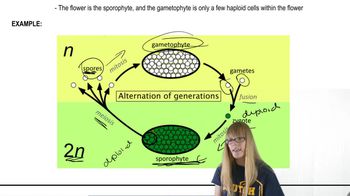Table of contents
- 1. Introduction to Genetics51m
- 2. Mendel's Laws of Inheritance3h 37m
- 3. Extensions to Mendelian Inheritance2h 41m
- 4. Genetic Mapping and Linkage2h 28m
- 5. Genetics of Bacteria and Viruses1h 21m
- 6. Chromosomal Variation1h 48m
- 7. DNA and Chromosome Structure56m
- 8. DNA Replication1h 10m
- 9. Mitosis and Meiosis1h 34m
- 10. Transcription1h 0m
- 11. Translation58m
- 12. Gene Regulation in Prokaryotes1h 19m
- 13. Gene Regulation in Eukaryotes44m
- 14. Genetic Control of Development44m
- 15. Genomes and Genomics1h 50m
- 16. Transposable Elements47m
- 17. Mutation, Repair, and Recombination1h 6m
- 18. Molecular Genetic Tools19m
- 19. Cancer Genetics29m
- 20. Quantitative Genetics1h 26m
- 21. Population Genetics50m
- 22. Evolutionary Genetics29m
7. DNA and Chromosome Structure
DNA Structure
Problem 10
Textbook Question
Draw the chemical structure of the three components of a nucleotide, and then link the three together. What atoms are removed from the structures when the linkages are formed?
 Verified step by step guidance
Verified step by step guidance1
Identify the three components of a nucleotide: a phosphate group, a pentose sugar (either ribose or deoxyribose), and a nitrogenous base (adenine, guanine, cytosine, thymine, or uracil).
Draw the chemical structure of the phosphate group, which consists of a phosphorus atom bonded to four oxygen atoms, one of which is double-bonded.
Draw the chemical structure of the pentose sugar. For DNA, use deoxyribose, which is a five-carbon sugar with the formula C5H10O4. For RNA, use ribose, which has the formula C5H10O5.
Draw the chemical structure of a nitrogenous base. Choose one of the bases: adenine, guanine, cytosine, thymine (for DNA), or uracil (for RNA).
Link the three components together: the phosphate group attaches to the 5' carbon of the sugar, and the nitrogenous base attaches to the 1' carbon of the sugar. During these linkages, a water molecule is removed (dehydration synthesis), specifically an OH from the phosphate and an H from the sugar, and an H from the sugar and an OH from the base.
Recommended similar problem, with video answer:
 Verified Solution
Verified SolutionThis video solution was recommended by our tutors as helpful for the problem above
Video duration:
1mPlay a video:
Was this helpful?
Key Concepts
Here are the essential concepts you must grasp in order to answer the question correctly.
Nucleotide Structure
A nucleotide is composed of three main components: a phosphate group, a five-carbon sugar (ribose in RNA or deoxyribose in DNA), and a nitrogenous base (adenine, thymine, cytosine, or guanine). The phosphate group is attached to the 5' carbon of the sugar, while the nitrogenous base is linked to the 1' carbon. Understanding this structure is essential for visualizing how nucleotides form the building blocks of nucleic acids.
Recommended video:
Guided course

DNA Structure
Phosphodiester Bond Formation
Nucleotides are linked together through phosphodiester bonds, which form between the phosphate group of one nucleotide and the hydroxyl group on the 3' carbon of another nucleotide's sugar. This linkage results in the formation of a sugar-phosphate backbone, crucial for the structural integrity of DNA and RNA. Recognizing this process is vital for understanding how nucleic acids are synthesized.
Recommended video:
Guided course

Formation of Plant Gametes
Dehydration Synthesis
The formation of phosphodiester bonds involves a dehydration synthesis reaction, where a water molecule is removed as the bond is formed. Specifically, a hydroxyl group (–OH) from the sugar and a hydrogen atom (–H) from the phosphate group are eliminated, resulting in the release of water. This concept is fundamental in biochemistry, as it highlights how macromolecules are constructed through the removal of water.
Recommended video:
Guided course

Translesion Synthesis
Related Videos
Related Practice



